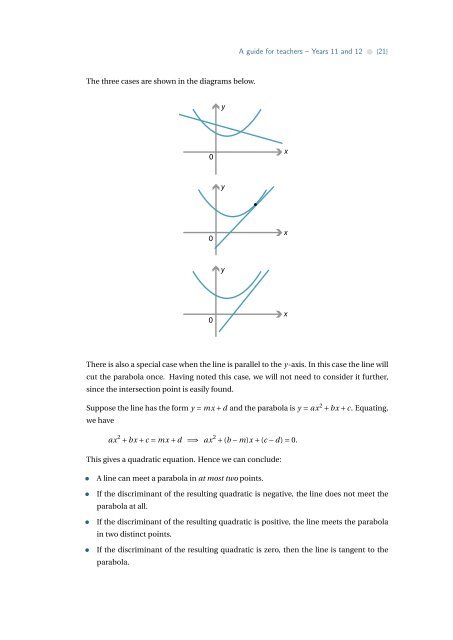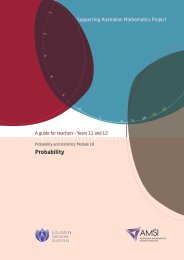Quadratics - the Australian Mathematical Sciences Institute
Quadratics - the Australian Mathematical Sciences Institute
Quadratics - the Australian Mathematical Sciences Institute
You also want an ePaper? Increase the reach of your titles
YUMPU automatically turns print PDFs into web optimized ePapers that Google loves.
A guide for teachers – Years 11 and 12 • {21}<br />
The three cases are shown in <strong>the</strong> diagrams below.<br />
y<br />
0<br />
x<br />
y<br />
0<br />
x<br />
y<br />
0<br />
x<br />
There is also a special case when <strong>the</strong> line is parallel to <strong>the</strong> y-axis. In this case <strong>the</strong> line will<br />
cut <strong>the</strong> parabola once. Having noted this case, we will not need to consider it fur<strong>the</strong>r,<br />
since <strong>the</strong> intersection point is easily found.<br />
Suppose <strong>the</strong> line has <strong>the</strong> form y = mx +d and <strong>the</strong> parabola is y = ax 2 +bx +c. Equating,<br />
we have<br />
ax 2 + bx + c = mx + d =⇒ ax 2 + (b − m)x + (c − d) = 0.<br />
This gives a quadratic equation. Hence we can conclude:<br />
• A line can meet a parabola in at most two points.<br />
• If <strong>the</strong> discriminant of <strong>the</strong> resulting quadratic is negative, <strong>the</strong> line does not meet <strong>the</strong><br />
parabola at all.<br />
• If <strong>the</strong> discriminant of <strong>the</strong> resulting quadratic is positive, <strong>the</strong> line meets <strong>the</strong> parabola<br />
in two distinct points.<br />
• If <strong>the</strong> discriminant of <strong>the</strong> resulting quadratic is zero, <strong>the</strong>n <strong>the</strong> line is tangent to <strong>the</strong><br />
parabola.
















